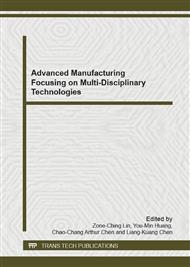[1]
Z.J. Pei, G.R. Fisher, J. Liu, Grinding of silicon wafers: A review from historical perspectives, Int. J. Mach. Tools Manuf., 48 (2008) 1297-1307.
DOI: 10.1016/j.ijmachtools.2008.05.009
Google Scholar
[2]
I. Kao, Technology and Research of Slurry Wiresaw Manufacturing Systems in Wafer Slicing with Free Abrasive Machining, International Journal of Advanced Manufacturing Systems, 7 (2004) 10-23.
Google Scholar
[3]
ITRS, International Technology Roadmap for Semiconductors 2010 Update, 2010, Information on http: /www. itrs. net/links/2010itrs/home2010. htm.
Google Scholar
[4]
D. Kray, M. Schumann, A. Eyer, G.P. Willeke, R. Kubler, J. Beinert, G. Kleer, in: 2006 IEEE 4th World Conference on Photovoltaic Energy Conversion, WCPEC-4, May 7, 2006 - May 12, 2006, Inst. of Elec. and Elec. Eng. Computer Society, Waikoloa, HI, United states, 2007, pp.948-951.
DOI: 10.1109/wcpec.2006.279613
Google Scholar
[5]
H.J. Moller, Basic mechanisms and models of multi-wire sawing, Advanced Engineering Materials, 6 (2004) 501-513.
DOI: 10.1002/adem.200400578
Google Scholar
[6]
J. Williams, Engineering Tribology, Cambridge University Press, New York, (2005).
Google Scholar
[7]
B.R. Lawn, A.G. Evans, D.B. Marshall, Elastic/Plastic Indentation Damage in Ceramics: The Median Radial Crack System, Journal of the American Ceramic Society, 63 (1980) 574-581.
DOI: 10.1111/j.1151-2916.1980.tb10768.x
Google Scholar
[8]
D.B. Marshall, B.R. Lawn, A.G. Evans, Elastic/Plastic Indentation Damage in Ceramics: The Lateral Crack System, Journal of the American Ceramic Society, 65 (1982) 561-566.
DOI: 10.1111/j.1151-2916.1982.tb10782.x
Google Scholar
[9]
B. Lawn, Fracture of Brittle Solids, Second ed., Cambridge University Press, New York, (1993).
Google Scholar
[10]
S. Bhagavat, I. Kao, Ultra-low load multiple indentation response of materials: In purview of wiresaw slicing and other free abrasive machining (FAM) processes, Int. J. Mach. Tools Manuf., 47 (2007) 666-672.
DOI: 10.1016/j.ijmachtools.2006.04.015
Google Scholar


